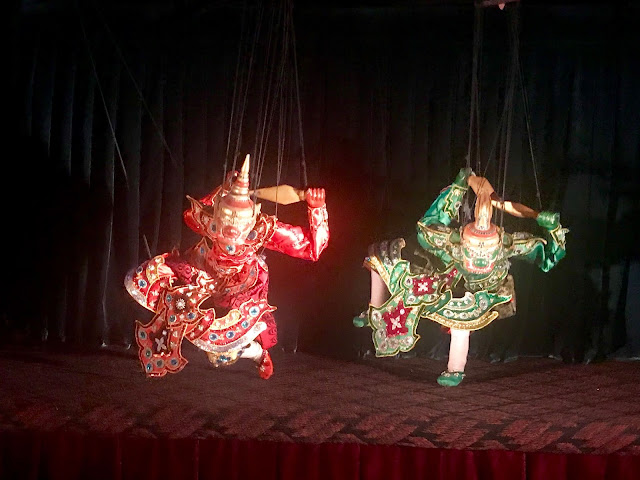 |
| မခိုင် ပေးဖတ်တဲ့ စစ်ပွဲဓာတ်ပုံသတင်းထောက် ဘဝအကြောင်းစာအုပ် |
ဝိုင်းက စုံထောက်စာအုပ်ပဲ ဖတ်တယ်။ ဝိုင်းညွှန်းတဲ့စာအုပ်က Anthony Horowitz ရဲ့ The word is murder စာအုပ်။ နာမည်ကြီးမင်းသားနဲ့ သူ့အမေ နာမည်ကြီးမင်းသမီးမှာ မုန်းတီးတဲ့သူလည်းမရှိ ... လူသတ်တရားခံရဲ့ ခြေရာလက်ရာလည်းမကျန်။ ဒါဆိုရင် ဘယ်သူသတ်တာလဲ... အိုး ... အင်မတန်စိတ်ဝင်စားစရာ ကောင်းတယ်။ မယုံရင် ကိုယ်တိုင်ဖတ်ကြည့် လက်ကမချချင် ဖြစ်လိမ့်မယ်။
 |
| ဝိုင်းညွှန်းတဲ့ စုံထောက်ဝထ္ထု ဖတ်လို့ကောင်းလိုက်တာ လက်ကမချနိုင်ဘူး Photo credit - Google |
ဆူနမ်၊ ရာမားတို့အိမ်ရောက်တော့ တွေ့တဲ့စာအုပ်က Agatha Christie ရဲ့ And then there were none ။ ဝိုင်းက အဲ့ဒီစာအုပ်က နာမည်ကြီးတယ် classic ပဲ ဖတ်ကြည့်လို့ညွှန်းတယ်။ ဝိုင်းက Agatha Christie ရဲ့ စာအုပ်တော်တော်များများကို ဖတ်ပြီးပြီး။
Ten little soldier boys went out to dine,
One choked his little self and then there were nine.
Nine little soldier stayed up very late;
One overslept himself and then there were eight.
Eight little soldier boys traveling in Devon;
One said he'd stay there and then there were seven.
Seven little soldier boys chopping up sticks;
One chopped himself in halves and then there were six.
Six little soldier boys playing with a hive;
A bumblebee stung one and then there were five.
Five little soldier boys going through a door;
One stubbed his toe and then there were four.
Four little soldier boys going out to sea;
A red herring swallowed one and then there were three.
Three little soldier boys walking in the zoo;
A big bear hugged one and then there were two.
Two little soldier boys sitting in the sun;
One got frizzled up and then there was one.
One little soldier boy left all alone;
He went and hanged himself and then there were none.
စစ်သားကျွှန်းကို ဧည့်သည်ဆယ်ယောက် ဖိတ်ခေါ်ခံရတယ်။ တယောက်ပြီးတယောက် အပေါ်က nursery rhyme ထဲကအတိုင်း အသတ်ခံရတယ် တရားခံက ဘယ်သူလဲ...။
 |
| ဝိုင်းညွှန်းတဲ့ စုံထောက်ဝထ္ထု စိတ်ဝင်စားဖို့ကောင်းတယ် |
မမီးငယ်က ကြည့်ဖြစ်အောင် ကြည့်စမ်းပါလို့ညွှန်းတဲ့ရုပ်ရှင်က Murder on the orient express။ ကြည့်လို့အင်မတန်ကောင်းတယ် ဝထ္ထုကပိုကောင်းတယ် Agatha Christie ရဲ့စာအုပ်ပဲ။
 |
| မမီးငယ်ညွှန်းတဲ့ ရုပ်ရှင်... ဝထ္ထုက ပိုကောင်းတယ် |
John Glenn ကမ္ဘာကိုမပတ်မှီ Neil Armstrong လပေါ်မှာ လမ်းမလျှောက်ခင် လူသားကွန်ပျူတာလို့ တင်စားကြတဲ့ လူမည်းအမျိုးသမီး သချာၤပညာရှင်တွေဟာ ဒုံးကျည်၊ အာကာသယာဉ်မှုးတွေ အာကသထဲရောက်ဖို့ ခဲတံတွေနဲ့ ဂဏ္ဏန်းနံပါတ်တွေ တွက်ချက်ခဲ့ကြတယ်။ ကမ္ဘာကို အကြိမ်ကြိမ်ပတ်ပြီး ကမ္ဘာ့ဆွဲငင်အားကို တွန်းကန်ကာ အာကသထဲ စတင်ပျံသန်းတဲ့နေရာမှာ တွက်ချက်မှုက အရေးကြီးပါတယ်။ တွက်ချက်မှုမှားရင် လိုရင်းနေရာမရောက်ဘဲ အဆုံးစွန်မဲ့အာကသထဲ လွှင့်မျောပြီး ပြန်လမ်းမရှိဖြစ်နိုင်တာကိုး။ အဲ့ဒီအချိန်တုန်းက စစ်အေးကာလ ရုရှနဲ့အမေရိကန် အာကာသကို စိုးမိုးဖို့ ကြိုးပမ်းနေချိန် ရုရှက အာကသထဲ ဒုံးပျံလွှင့်တင်နိုင်တော့ နာဆာက တခုခုလွှင့်တင်နိုင်ဖို့ သေကောင်းပေါင်းလဲ ကြိုးစားရတယ်။ လူဖြူလူမည်း ခွဲခြားမှုပြင်းထန်တဲ့အချိန်မှာ လူမည်းအမျိုးသမီး သချာၤပညာရှင်တွေရဲ့ တွက်ချက်မှုတွေကို လူဖြူအာကာသယာဉ်မှုးတွေက ယုံကြည့်ပါ့မလား။ ဒီတခါတော့ ဝထ္ထုထက် ရုပ်ရှင်က ပိုကောင်းတယ်။ Margot Lee Shetterly ရဲ့ ပထမဆုံးစာအုပ်ဖြစ်ပြီး သူ့ကြောင့်သာ လူမသိကြတဲ့ လူမည်းသချာၤပညာရှင် အမျိုးသမီးတွေရဲ့ စွမ်းဆောင်ချက်ကို သိခွင့်ရတယ်။
ခုလောလောဆယ် ဖတ်နေတာက Michelle Obama ရဲ့ Becoming ။ အိုဘာမားတို့ကို လေးစားတယ် အလယ်အလတ်တန်းစား လူတန်းစားကနေ ကြိ ုးစားလို့ သမ္မတဖြစ်လာတယ်။ သူတို့နဲ့ပြောပုံဆိုပုံ၊ အတွေးအခါ်၊ အယူအဆတွေကို သဘောကျတယ်။ လိုင်ဘရီမှာ waitinglist တထောင်ကျော် စောင့်ရတယ် ရပြန်တော့လည်း နှစ်ပတ်ပဲရတယ်။ နောက်တကြိမ်ထပ်ငှားပြီး ထပ်ဖတ်နေတယ်။ စာရေးကောင်းတယ် စကားအသုံးအနှုန်းတွေ သဘောကျလို့ Audio Book ထပ်နားထောင်ဦးမယ်။ စန်းထွန်းကို ဖတ်စေချင်တဲ့ ညွှန်းချင်တဲ့စာအုပ်ရှိရင် ရှယ်ပါဦးနော်။ စာအုပ်ကောင်းကောင်း၊ ရုပ်ရှင်ကောင်းကောင်း၊ ပစ္စည်းကောင်းကောင်း၊ အစားအသောက် ကောင်းကောင်းလေးတွေညွှန်းရင် သိပ်သဘောကျတာပဲ။
Happy reading !
စန်းထွန်း
သြဂုတ် ၂၈၊ ၂၀၁၉ ။
 |
| လူလတ်တန်းစားဘဝကနေ ကြိုးစားလို့ သမ္မတဖြစ်လာတဲ့ အိုဘားမားတို့ကို တကယ်လေးစားအားကျတယ် သူတို့ရဲ့ အပြုအမှု အပြောအဆို အတွေးအခါ် အယူအဆကို တကယ်သဘောကျတယ် |





























